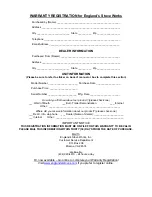
SECTION lll: FREESTANDING PLACEMENT AND INSTALLATION
Once you have your flue system complete and have installed the floor and wall
protection, you are ready to place your unit. The first problem you may encounter is
getting the stove into your home; all of our products are well constructed, which makes
them rather heavy. To lighten the stove you can remove the door and firebrick. Be sure
to make a note of your unit’s brick placement before you remove your bricks.
After the unit is in place the firebrick and door can be replaced. We recommend you
use a handcart and never try handling one of our units without some help. As a rule,
three or four adults can handle most of our products.
A. Chimney Connector
The chimney connector must be 24 gauge steel pipe and six inches (6”) in
diameter. Do not use aluminum or galvanized pipe for installation of this unit, as this
type pipe will not be able to withstand the extreme temperatures a wood stove will
generate. Do not use chimney connector pipe (single wall) as a chimney. You must
connect your stove to a chimney comparable to those listed previously in this manual
(See Section l).
A chimney connector must be attached to the stove (and to each other) with the
crimped end toward the stove. This allows any creosote to run back inside the pipe
and not down the outside of the pipe. As a safety precaution, all joints should be
sealed with high temperature silicone (AC-RTV3) and secured with three sheet metal
screws, since the pipe could vibrate apart in the event of a creosote fire.
For proper operation, the chimney connector should be as short as possible.
Horizontal runs of chimney connector pipe should have an upward slope from the
stove of one-quarter inch (1/4") per foot. Maintain eighteen inches (18”) of clearance
between the chimney connector and the wall and ceiling unless a wall protection
system is installed. When installing this stove in a mobile home or double wide you
must use double wall or shielded pipe that will allow six inches (6”) clearance from a
combustible.
B. Outside Air Connection
When installing this model in a mobile home or double wide it is necessary to
supply the combustion air into the unit from outside the dwelling. This can be done
by running a thin gauge three inch (3”) pipe (flex or rigid) from the air inlet pipe
located on the rear of the stove through the floor or wall. The outside end of this pipe
should be covered in some manner to keep it clear of foreign matter. If you are
installing this stove in a regular dwelling this connection is not necessary, but is
recommended in air-tight homes.
Содержание 18-MH
Страница 16: ......



































